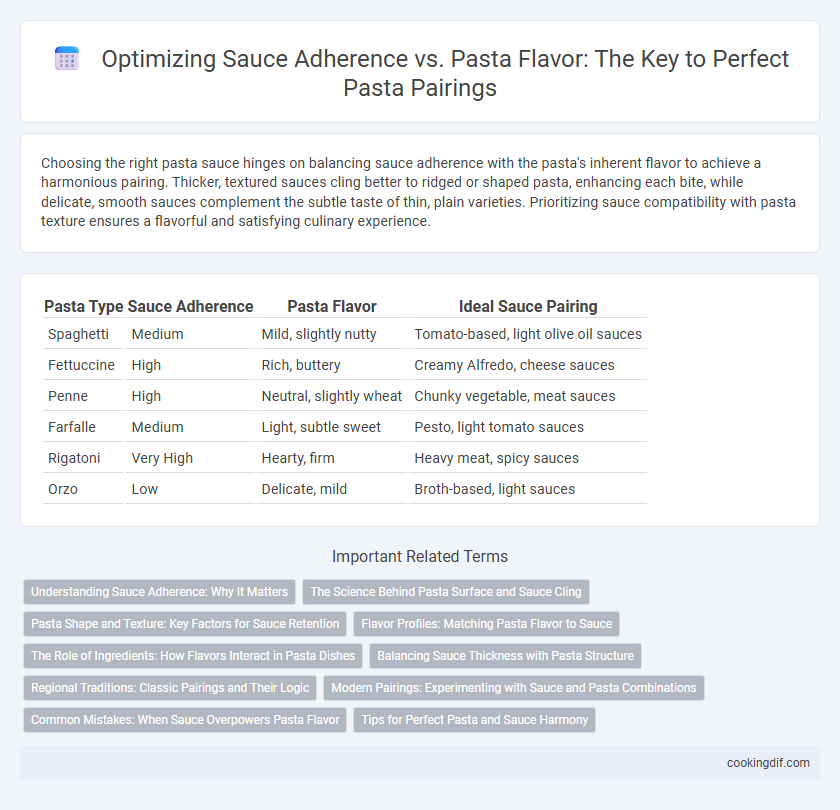Choosing the right pasta sauce hinges on balancing sauce adherence with the pasta's inherent flavor to achieve a harmonious pairing. Thicker, textured sauces cling better to ridged or shaped pasta, enhancing each bite, while delicate, smooth sauces complement the subtle taste of thin, plain varieties. Prioritizing sauce compatibility with pasta texture ensures a flavorful and satisfying culinary experience.
Table of Comparison
| Pasta Type | Sauce Adherence | Pasta Flavor | Ideal Sauce Pairing |
|---|---|---|---|
| Spaghetti | Medium | Mild, slightly nutty | Tomato-based, light olive oil sauces |
| Fettuccine | High | Rich, buttery | Creamy Alfredo, cheese sauces |
| Penne | High | Neutral, slightly wheat | Chunky vegetable, meat sauces |
| Farfalle | Medium | Light, subtle sweet | Pesto, light tomato sauces |
| Rigatoni | Very High | Hearty, firm | Heavy meat, spicy sauces |
| Orzo | Low | Delicate, mild | Broth-based, light sauces |
Understanding Sauce Adherence: Why It Matters
Sauce adherence is crucial for enhancing the overall pasta experience, as it determines how well the sauce clings to each strand or piece, intensifying flavor with every bite. Different pasta shapes and textures, such as ridged penne or rough-cut pappardelle, improve adhesion by providing surface area and grip, allowing richer, more balanced flavor integration. Mastering sauce adherence ensures the ideal harmony between pasta and sauce, elevating dishes like creamy Alfredo or robust Bolognese by maximizing taste absorption and mouthfeel.
The Science Behind Pasta Surface and Sauce Cling
Pasta surface texture plays a critical role in sauce adherence, directly influencing flavor pairing success by enhancing the balance between sauce and noodle. A rougher pasta surface, often achieved through bronze-die extrusion, creates micro-roughness that traps sauce molecules more effectively than smooth pasta, ensuring a harmonious blend of flavors in each bite. Understanding starch gelatinization and protein structure during pasta drying also optimizes sauce cling, making textural interplay essential for maximizing taste experience.
Pasta Shape and Texture: Key Factors for Sauce Retention
Pasta shape and texture play a crucial role in sauce adherence and flavor pairing, as ridged or rough surfaces like rigatoni or fusilli trap sauces more effectively than smooth varieties such as spaghetti. Thicker, sturdier pastas support hearty, chunky sauces, allowing flavors to cling to the pasta and enhance each bite. Selecting pasta shapes that complement the sauce texture maximizes taste harmony and ensures a balanced culinary experience.
Flavor Profiles: Matching Pasta Flavor to Sauce
Balancing pasta flavor with sauce adherence requires understanding the texture and surface of different pasta types; ridged or hollow shapes like rigatoni or penne better capture chunky sauces, enhancing the overall taste experience. Creamy sauces complement delicate pasta like angel hair, allowing subtle flavors to shine through without overpowering. Pairing robust, herb-infused sauces with heartier whole wheat or spinach pasta creates a harmonious flavor profile that elevates both elements.
The Role of Ingredients: How Flavors Interact in Pasta Dishes
Sauce adherence plays a crucial role in balancing pasta flavor, with ingredient texture and composition directly affecting how well the sauce clings to noodles like spaghetti, fettuccine, or ravioli. Ingredients such as olive oil, cheese, and starch from pasta water create emulsions that enhance flavor integration and prevent separation, optimizing each bite's taste profile. Understanding the interaction between acidic elements like tomato and fatty components in sauces intensifies pasta flavor, making ingredient pairing essential for a harmonious dish.
Balancing Sauce Thickness with Pasta Structure
Balancing sauce thickness with pasta structure is essential for optimal sauce adherence and flavor harmony. Thicker sauces like ragu cling better to robust pastas such as rigatoni or pappardelle, enhancing every bite, while lighter sauces pair well with delicate shapes like angel hair or capellini to prevent overpowering the pasta's subtle flavor. Matching sauce viscosity to pasta texture maximizes the overall taste experience, ensuring neither element dominates the palate.
Regional Traditions: Classic Pairings and Their Logic
Traditional Italian regional pasta dishes showcase a deep understanding of sauce adherence and pasta flavor harmony, like the Ligurian pairing of basil pesto with trofie, where the sauce's oily texture clings perfectly to the twisted shape. In Emilia-Romagna, rich ragu alla bolognese complements broad tagliatelle as the flat surface captures the hearty meat sauce, balancing robust flavors and textures. These time-honored combinations highlight how pasta shape and sauce consistency co-evolved regionally to optimize flavor absorption and mouthfeel.
Modern Pairings: Experimenting with Sauce and Pasta Combinations
Modern pairings emphasize balancing sauce adherence with pasta flavor to enhance the overall taste experience; thicker sauces like Alfredo or Bolognese cling better to ridged or tubular pasta such as rigatoni or penne, boosting flavor absorption. Lighter sauces like aglio e olio pair well with delicate strands like angel hair to preserve the pasta's subtle texture and taste. Experimenting with sauce viscosity alongside pasta shape unlocks diverse flavor profiles and texture contrasts for innovative culinary creations.
Common Mistakes: When Sauce Overpowers Pasta Flavor
Sauce adherence plays a critical role in pasta flavor pairing, as an overly thick or heavy sauce can mask the pasta's natural taste and texture. Common mistakes include using rich cream-based sauces on delicate pastas like angel hair, which overwhelm subtle wheat nuances. Balancing sauce consistency and intensity ensures both ingredients complement each other, enhancing the overall dining experience.
Tips for Perfect Pasta and Sauce Harmony
Sauce adherence plays a crucial role in enhancing pasta flavor, with rougher pasta shapes like rigatoni or fusilli providing better sauce grip than smooth varieties such as spaghetti. Selecting sauces with complementary textures, like thicker ragus for hearty pappardelle or lighter olive oil-based sauces for delicate angel hair, elevates the overall taste experience. Ensuring pasta is cooked al dente also improves sauce absorption, allowing flavors to meld seamlessly for perfect pasta and sauce harmony.
Sauce adherence vs pasta flavor for pairing Infographic

 cookingdif.com
cookingdif.com